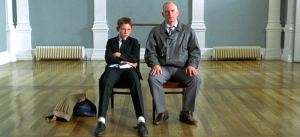Billy Elliot
Top Videos
Playwright
Lee Hall
Hall was born in Newcastle upon Tyne, Tyne & Wear, in 1966. Hall’s most commercially successful work is Billy Elliot, the story of a North Eastern English boy who, in the face of opposition from his family and community, aspires to be a ballet dancer. The inspiration for the screenplay was drawn, in part, from the A. J. Cronin novel The Stars Look Down, which is also set in an English coal mining community during a strike and similarly tells the story of a miner’s son who goes against the grain.
Synopsis
The life of 11-year-old Billy Elliot, a coal miner’s son in Northern England, is forever changed one day when he stumbles upon a ballet class during his weekly boxing lesson. Before long, he finds himself in dance, demonstrating the kind of raw talent seldom seen by the class’ exacting instructor, Mrs. Wilkinson. With a tart tongue and a never-ending stream of cigarettes in her hand, Mrs. Wilkinson’s zest for teaching is revived when she sees Billy’s potential.
Billy Elliot Resources
Top Academic articles
Dixon, Mel. Critical pedagogy and Billy Elliot. Metaphor, No. 2, Jun 2013: 47-50
Judy, Jon. Better to Be a Dancer Than a Miner: Commonalities in ‘Billy Elliot’
Alan Sinfield. Boys, Class and Gender: From Billy Casper to Billy Elliot. History Workshop Journal No. 62 (Autumn, 2006), pp. 166-171
Archard, Nicole. ‘Always Be Yourself’: Identity and Acceptance in Billy Elliot. Screen Education, No. 49, 2008: 137-140
Simmons, Gary. The Gloves are Off, Billy’s Pumped: Gender and Class Politics in ‘Billy Elliot’. Screen Education, No. 44, 2006: 119-123
Useful websites
What Billy Elliot taught us about British history
 Sally Koller-Alonso explores the key themes of Billy Elliot and the context of the film.
Sally Koller-Alonso explores the key themes of Billy Elliot and the context of the film.
Billy Elliot’s director explains the true meaning behind the film’s most memorable scene
“It’s also a story we all know—someone trying to express himself or herself.”
 Despite its record in ticket sales and millions of visitors, Billy Elliot did not end up changing gender stereotypes.
Despite its record in ticket sales and millions of visitors, Billy Elliot did not end up changing gender stereotypes.








